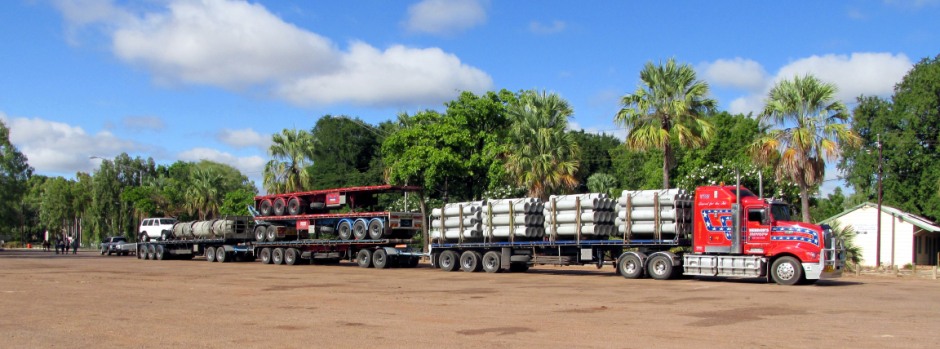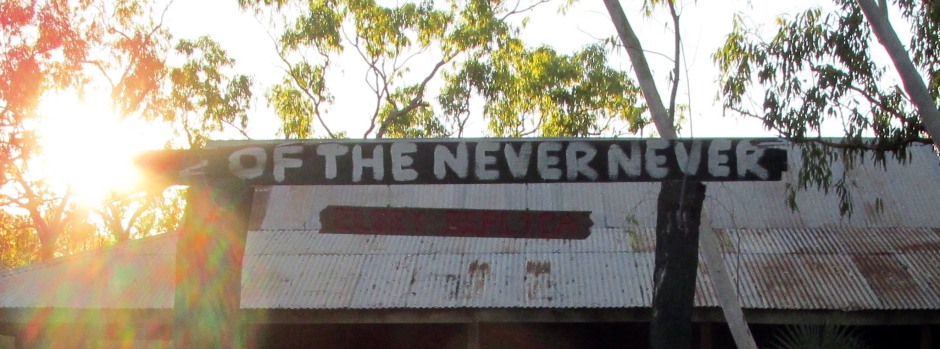Mataranka & Elsey National Park
Mataranka is a small town in the Top End region of Australia's Northern Territory. It lies about 420km southeast of Darwin and 107km south of Katherine in an area the Scottish explorer John McDouall Stuart described as "simply magnificent". The town is situated near Roper River and Mataranka Hot Springs; the popular Mataranka Thermal Pool maintains a constant 34°C with 22.5 million litres of crystal clear water flowing through it each day. In addition, another thermal pool at Bitter Springs may be found at the other end of the town. The town itself lies on the Stuart Highway (which runs 2,834 km from Darwin in the North to Port Augusta in the South via Alice Springs) and offers a wide range of amenities. During the war years, The Australian Army set up No. 42 Australian Camp Hospital near the town and the 10th Australian Advanced Ordnance workshops repaired damaged vehicles. An ammunition depot was also in near here.

Above: Road Trains are commonplace on the Stuart Highway, which runs straight through the town of Mataranka.
Mataranka was served by a narrow gauge railway until 1976 due to cyclone damage. Today, the legendary Ghan Train passes some 20km west of here on a modern standard gauge railway line, the Alice Springs to Darwin section having opened in January 2004.
 |
 |
|
 |
 |
Above: Roadside views in the town of Mataranka
Mataranka is made famous by the book (and film) "We of the Never Never" by Jeannie Gunn and there is more about this further down the page.

Extending from 2 km to 19 km east of Mataranka lies Elsey National Park. The park is noted for Elsey Falls, its birdlife and as a popular place for fishing. Within the ark, springs feed Roper River which flows through large waterholes, tumbling over rocks into pools. The Roper River, itself is formed by the confluence of the Waterhouse River and Roper Creek and floods during the wet season. The waters and forests of the Roper River's headwaters supported Mangarrayi and Yangman Aboriginal people for millennia. Many of the natural features of the park are important to these people; they believe that spirit ancestors who created the surrounding landscape are still present in these places. The Mangarrayi and Yangman Aboriginal people now live in communities close-by and help with making decisions on the park's management.
The thumbnail photo gallery above shows the Mataranka Homestead Tourist Resort (photos 2-16) and the surrounding section of Elsey National Park (photos 17-32). This lies to the east of the town. A particular favourite with respect to the camping experience (where else on Earth can you find a site to park up your motor home that has its own airstrip and thermal pool?). The resort is framed by two rivers and the Elsey National Park and offers a 34°C thermal pool, bush walking trails, barramundi fishing, live nightly live entertainment, a bistro & bar, mini mart and gift shop. As well as powered sites for motor homes and caravans here, there are cabins and motel or backpacker hostel options available.
Mataranka's spring fed thermal pool is a 200m walk along a path from the campground. The popular crystal clear waters make an excellent place to swim or simply relax. The springs have been used for recreation for many years, providing a swimming spot for early pastoralists (sheep or cattle farmers) and for navvies working on the Darwin to Mataranka railway in 1928. The channel leading from the Waterhouse river to the spring was enlarged by soldiers stationed in Mataranka during World War II followed by construction of the pool. This provided a place of recreation for officers only. After the war, one of the soldiers leased Mataranka Homestead and opened the thermal pool up to tourists. The area here is surrounded by palm and paperbark forest which attracts little red flying-foxes (bats) from around October-time to feast on eucalypt flowers in the nearby woodlands and rest here during the daytime. Beyond the pool, the path leads up to the bank of the nearby Waterhouse River. The river is a haven for wildlife, attracting the White-bellied Sea-eagle, which feeds on fish and hunts flying-foxes and the Azure Kingfisher. Other wildlife found in this area includes aquatic insects, frogs, Common Tree Snakes and Mertens' Water Monitor, a member of the monitor lizard family which feeds both on land and in the water, growing up to a length of about 1m. In addition to the path leading to the thermal pool and Waterhouse River, a short loop track (Rainbow Spring Loop Walk) takes the visitor through cabbage palm forest to the Waterhole River (which runs into the Waterhouse River) and on to Rainbow Springs, the source of the thermal pool. Other walks through the Elsey National Park which can be taken from here are a riverside walk (16km to Korowan (Mataranka Falls)) and a walk to Stevie's Hole (1.2km one way), which is a rarely crowded natural swimming hole in the cooler Waterhouse River. It is important to note that here, in the Elsey National Park, swimming in the rivers and various pools is not always permitted due to the danger posed by saltwater (estuarine) crocodiles during the wet season. After each wet season, the rivers are patrolled for them, before the areas are declared open for swimming.

Above: In Mataranka on the main Stuart Highway is the Never Never Museum, which has displays informing the visitor about Aboriginal and local history, the overland telegraph line, the area's role during World War II and the North Australian Railway. It is worth noting here that the museum is not open at weekends and entrance is via the adjacent Rural Transaction Centre.

We of the Never Never
As mentioned further up this page, Mataranka is made famous by the book "We of the Never Never" by Jeannie Gunn. The book was made into a film of the same name in 1982 which was shot on location in the Northern Territory, where the novel is set. At the start of 1902, Jeannie Gunn, a schoolteacher from Melbourne, went with her husband to live on the remote Elsey Cattle Station near the Roper river. Although she spent little more than a year there, her experiences with life in the bush, the Aboriginal people and characters she met had a profound impact on her. "We of the Never Never" is one of two autobiographical novels based on these experiences she wrote on her return to Melbourne (the other being "The Little Black Princess"). The book "We of the Never Never" was originally published under the name Mrs Aeneas Gunn, with Jeannie using her husband's name. Gunn was the first white woman to settle in the Mataranka area with her husband who was to become the person in charge (Maluka) of the Cattle Station. Before moving to Elsey, Jeannie was discouraged from accompanying him on the basis that as a woman she would be "out of place" on a station such this one. Her book describes the journey and settling in and recounts her time spent changing the names of people to obscure their identities. However, tragedy struck on 16 March 1903, when Aeneas died of malarial dysentery and Jeannie returned to Melbourne shortly afterwards. "We of the Never Never", which was also translated into German in 1927, had sold 320,000 copies by 1945 and by 1990, this figure reached over one million. Both books are regarded as classics of Australian literature and have been loved by generations. Popular in schools, they have historical importance in defining the Australian identity. A modern review of the book from The Australian may be found here (external link).
The Mataranka Never Never Festival runs over a weekend at the end of May with various activities on offer. In and around modern day Mataranka, it is possible to see several sites relating to "We of the Never Never"; some photos and text with respect to these follows.

 |
 |
|
 |
 |
Above: Stan Martin Park in Mataranka, next to the Stuart Highway, contains life size characters from the book. The figures were created by Yvonne Dorwood in 2000 and are of (lower four photos, clockwise from top-left): Aeneas & Jeannie Gunn, an Aboriginal Stockman, Cheon (who was a Chinese cook on Elsey Station) and Bett-Bett (the Little Black Princess) & her dog, Sue.
 |
 |
|
 |
 |
Above: Next to the Mataranka Homestead Tourist Resort is to be found a replica of the Elsey Station homestead which Jeannie Gunn shared with her husband, Aeneas, until his death. The replica was made in 1981 for the "We of the Never Never" film. Although it's true likeness is a matter of debate, a lot of attention to detail was given during its construction, drawing on research by archaeologists, historians and architects. Following the filming, the replica was moved to this spot and inside are a number of artefacts and historic information on display.
Thumbnail photo gallery above: 21km south of Mataranka is the Elsey Cemetery, where graves include those of Jeannie Gunn's Husband, Aeneas and many of the real-life people whom formed characters in her book. A memorial to Jeannie is adjacent to her husband's grave; she died back in Melbourne in 1961, only to be outlived by Bett-Bett (The Little Black Princess), who died in Darwin in 1988, aged 95.
 |
 |
|
 |
 |
Above: 300m from the cemetery is a rock cairn with a plaque on it which marks the site of the original Elsey Cattle Station. The station comprised the homestead itself, a kitchen, meathouse, quarters, blacksmiths, wagon shed and harness room, yards and a cemetery.

References and Further Reading
1. Exploring the Stuart Highway and Oodnadatta
Track Adelaide to Darwin. Balhannah, SA: Tourist Information
Distributors Australia.
2. In situ public information boards
3. Elsey
National Park fact sheet and map from the Northern Territory Government
website here
4. Rawlings-Way, C., Worby, M. and Brown, L. (2013).
Central Australia. Footscray, Vic.: Lonely Planet.
5. Gunn, J. (1907).
We of the Never Never. Melbourne.
Back to Top